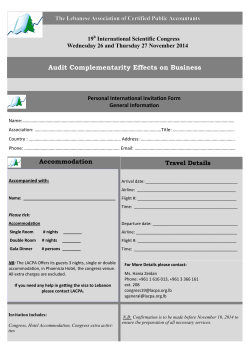
SLIDES-Unquantified Benefits
Unquantified Benefits Jonathan Masur & Eric Posner University of Chicago Law School May 2015 U.S. Regulations, 2010-2013 Agency Action Number Partly quantified costs and benefits 48 Did not quantify benefits 36 Did not quantify costs 9 Did not quantify benefits and costs 11 Fully quantified benefits and costs 4 Total 108 The Problem • Agencies routinely fail to quantify (in monetary terms) all major benefits (and costs) of regulations • This leads to overregulation when regulators exaggerate unquantified benefits • It also leads to underregulation when regulators disregard them • They provide two standard explanations • Empirical uncertainty • Effect of mercury ingestion on heart attack rate • Effect of nutritionally superior lunches on children’s health • Unquantifiable in principle • Dignitary benefits to disabled people • Equity benefits to veterans The Solution • Bayesian Cost-Benefit Analysis • Regulators should use priors • They should publicly state their priors • They should use “back-of-the-envelope” calculations, however speculative • The problem of uncertainty should be addressed institutionally • • • • Interagency consistency Proper updating over time Institutional mechanisms for revisiting and updating earlier estimates “Dignitary” concerns should be monetized. • Equity claims should be quantified Example: EEOC’s ADA regulations • These regulations broadened the definition of disability, enabling more people to claim accommodations • Costs • • • • 12-38.4 million people fall under the broader definition 2-6.1 million people would be entitled to a new accommodation Mean cost of accommodation is $150 Total cost approximately $60-$183 million / year (after further adjustments) • Benefits • • • • Initially, no quantification Survey suggests that cost of hiring a replacement is $2000 Perhaps multiply this by 2-6 million, which would equal $4-12 billion Additional unquantified benefits • “Efficiencies in litigation” • “Fuller employment,” which would “stimulate the economy” • “Non-discrimination,” which would reduce “stigma, exclusion, and humiliation, and promote self-respect” • Plainly inadequate • No evidence that workers would need to be replaced • Replacement cost not calibrated to replacements avoided • No explanation for why employers would not voluntarily provide accommodations in order to avoid much higher replacement costs • No analysis of effects on employment market • No analysis of effects on litigation • No analysis of effects of accommodation on stigma, and so on A better approach to quantifying benefits • Use surveys to: • • • • Determine the types of employment affected by regulation Typical accommodation in a given type of job for a given type of disability How much workers value those accommodations Aggregate • Take into account employer reactions • Will employers raise prices, lower wages, worsen conditions, etc.? • Will employers hire fewer disabled people (as evidence suggests) • Even where the regulator must guess, it can provide a mechanism for retroactive evaluation
© Copyright 2025










